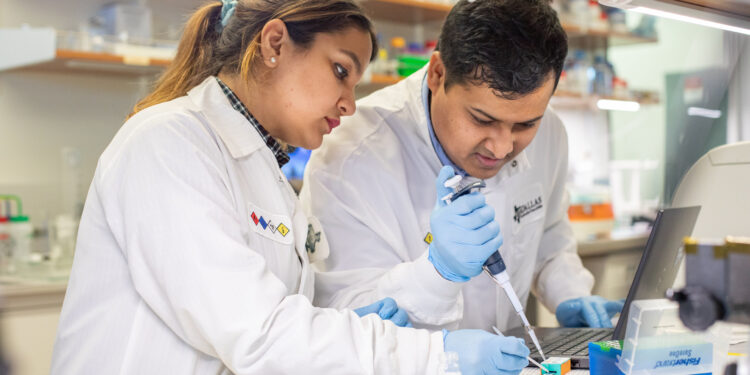UT Dallas bioengineering researchers Ivneet Banga Ph.D.’23 and Dr. Anirban Paul demonstrate how a sensor developed by their team can detect fentanyl. Researchers drop liquid directly onto the sensor platform, which is connected to a laptop and provides results within seconds. Credit: University of Texas at Dallas
Researchers at the University of Texas at Dallas have developed a first-of-its-kind wearable electrochemical sensor that can accurately detect fentanyl in urine within seconds.
The proof-of-concept technology can detect even trace amounts of fentanyl with 98% accuracy using a small, handheld device without costly and time-consuming laboratory analysis. A study demonstrating the device was published in the January 10 print edition of Applied materials and interfaces.
The prototype, which could be used to test for fentanyl via urine analysis, is a precursor to a test to detect the drug in saliva, said Dr. Shalini Prasad, professor and head of the department of bioengineering at the Erik Jonsson School of Engineering and Computer Science. The technology could also be used to test substances for fentanyl by mixing a sample with water and dropping the liquid onto the sensor.
“There is an urgent demand for a miniaturized, portable, easy-to-use device that can detect fentanyl with high specificity and immediately share the results with an Internet-connected device,” said Prasad, corresponding author of the study. and Cecil H. and Ida Green Professor of Systems Biology. “Our study demonstrates the feasibility of a highly accurate sensor to detect fentanyl in seconds.”
Fentanyl is a synthetic opioid 50 times more potent than heroin and 100 times more potent than morphine, according to the Centers for Disease Control and Prevention. Illegally manufactured fentanyl is usually mixed with other drugs, and an amount as small as 2 milligrams, the equivalent of 10 to 15 grains of table salt, can be deadly. More than 150 people die every day from overdoses linked to synthetic opioids like fentanyl.
Research has determined that fentanyl is detectable in urine for up to 72 hours. UT Dallas researchers are working to advance technology to detect fentanyl in hair. Their ultimate goal is to develop a test to detect fentanyl in saliva. A saliva test could help first responders make treatment decisions for someone overdosing, Prasad said.
The device contains an electrochemical sensor that generates electrical signals based on chemical reactions. Developing a sensor to detect fentanyl, however, posed a challenge because the synthetic opioid is a non-volatile compound, meaning it does not produce an electrochemical signature.
From left: Dr. Sriram Muthukumar, Dr. Anirban Paul, Dr. Shalini Prasad, and Ivneet Banga Ph.D.’23 developed a sensor that can detect even trace amounts of fentanyl with 98% accuracy. Credit: University of Texas at Dallas
To capture fentanyl with an electrochemical sensor, the researchers used a cage-like molecular structure that they compared to a mousetrap. The trap is made up of several substances, including gold nanoparticles. For the “cheese”, the researchers had to get creative.
Bioengineering researcher Dr. Anirban Paul, first author of the paper, used reverse engineering to find a solution. Paul, who left India to work with Prasad, decided to try using naloxone, a life-saving medication that can reverse an opioid overdose. Researchers conducted computer tests to understand how the compounds interact to determine how to deploy naloxone to attract fentanyl like a magnet.
“Naloxone is used to lessen the potency of fentanyl,” Paul said. “I had the idea of using naloxone to catch fentanyl, like cheese to catch a mouse.”
Researchers tested urine from a laboratory spiked with low, medium and high levels of fentanyl. Urine is poured onto a test strip. If the drug is present, naloxone interacts with it and generates a signal. The device detected fentanyl at up to 100 parts per million in spiked urine samples.
Study author Ivneet Banga Ph.D.’23, bioengineering research project leader, helped plan the experiments and synthesize the materials. Last year, as a doctoral student, Banga won a second-tier Baxter Young Investigator Award for a portable breath analyzer that can detect respiratory illnesses, including COVID-19, in seconds. She said she hopes the fentanyl sensor can help prevent overdose deaths.
Prasad and his team have developed a variety of electrochemical sensors, including technology to detect biomarkers of infections, such as COVID-19, in sweat, as well as biomarkers of inflammatory bowel disease flare-ups. Last year, they developed a test to measure THC, a major active component of marijuana, in saliva with 94 percent accuracy.
The fentanyl sensor was developed in collaboration with EnLiSense, an Allen, Texas, company that develops lifestyle-based sensors and devices. Prasad and co-author of the current study, Dr. Sriram Muthukumar, are co-founders of EnLiSense.
More information:
Anirban Paul et al, Naloxone-AuNPs@ZIF-8-based Impedimetric Sensor Platform for Ultrasensitive Fentanyl Detection and Fen-Track Prototype Fabrication for Real-Field Analysis, ACS Applied Materials and Interfaces (2023). DOI: 10.1021/acsami.3c14246
Provided by the University of Texas at Dallas
Quote: Researchers develop rapid test to detect fentanyl (2024, February 5) retrieved February 5, 2024 from
This document is subject to copyright. Except for fair use for private study or research purposes, no part may be reproduced without written permission. The content is provided for information only.



